
The V12 Engine gives an unprecedented and in-depth overview of the significant and important V12-powered cars and the magnificent engines that powered them, from the smallest, the 1.1-litre Itala of 1926, to the largest, the 112-litre “Quad Al” of 1965 powered by four Allison twelves.
Karl Ludvigsen, award-winnng automotive historian and author of the acclaimed Porsche: Origin of the Species takes the reader behind the scenes of the creation of the greatest twelves of all time, from the effortless urge of the luxurious Hispano-Suiza of the 1930s to the scintillating surge of the Lamborghini supercars of the 1960s. You’re trackside at the epic battles of Grand Prix twelves in the 1930s and 1990s and you’re in the boardrooms of BMW, Audi and Mercedes-Benz as they battle for V12 supremacy into the 21st Century.
From the first-ever V12 engine of 1904, Ludvigsen traces the type’s evolution through the first European twelve, a 1913 Sunbeam, to the 1915 Packard in America, inspired by a 1908 Schebler. In 1917 Americas mania for multicylinders saw 16 marques offering V12 cars at New York’s show. Britain’s Daimler pioneered them in Europe, where Horch, Tatra, Voisin, Maybach and Hispano-Suiza built twelves.
Not all were successful. Lagonda had mixed fortunes with its twelves and Rolls-Royces Phantom III was an epic loss-maker. Cadillac left its “V-Future” V12 in the garage while Mercedes-Benz made only a handful of its twelves before World War II stopped play. Among Formula 1 entries the efforts of Porsche, MGN and Life were pitiful flops while Honda, Ferrari, BRM and Matra enjoyed success.
Lavishly illustrating The V12 Engine with rare photos and drawings from his Ludvigsen Library, the author explains how and why twelves evolved as they did and introduces such major movers as Jesse Vincent of Packard, Sunbeam’s Louis Coatalen, Louis Delage, W.O. Bentley, Sir Henry Royce, Hispano’s Marc Birkigt, Ferruccio Lamhorghini, Sir William Lyons of Jaguar, Bugatti’s Paolo Stanzani and, of course, Enzo Ferrari. He brings to life their struggles to achieve their aims and quotes contemporary verdicts on their cars.
Ferrari’s fabulous Enzo V12 brings the story up to date, along with contemporary twelve-cylinder engines from Mercedes-Benz, Lamborghini, BMW, Maybach, Aston Martin, Maserati and Rolls-Royce, and such newcomers to the V12 ranks as Toyota, Bentley, Volkswagen, Cadillac, Peugeot and Audi.
Blending business with technology, racing with record-breaking and luxury carriages with supercars, The V12 Engine takes the reader on a high-speed journey through some of the most exciting and exotic cars ever made.
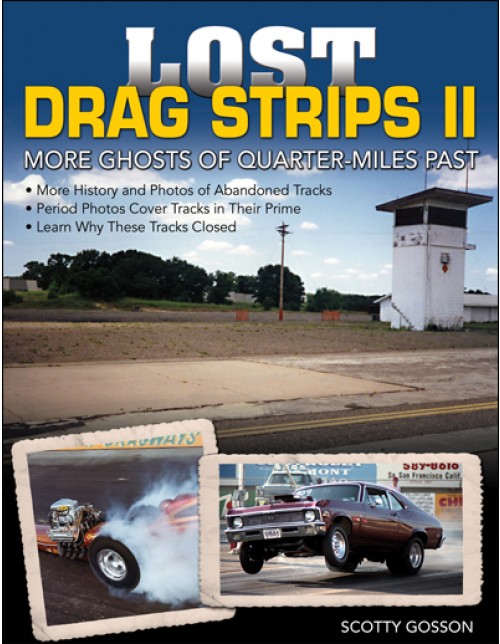
More Ghosts of Quarter-Miles Past
Fresh on the heels of the best-selling book Lost Drag Strips comes a new look at other long-lost and forgotten drag racing facilities from the 1950s, 1960s, and 1970s.
In the first volume, the author examined the birth of drag racing and its subsequent popularity that invaded every city and community across America. Unfortunately, after the initial explosion of popularity, it waned, and various drag strips closed for a myriad of reasons. Financial pressure for the real estate they occupied, suburban sprawl, and waning participation were all reasons for the change in fortunes for the small, and even not-so-small, racetracks. The first volume was great, but readers demanded more!
Lost Drag Strips II picks up where the first volume left off, covering even more tracks with archival photos of racing in the tracks’ heyday, the cars that ran there, and coverage of the tracks as they exist today. This volume also includes some of the tracks that survived, those that fought off the economic demons and the urban sprawl and continue to run today.
Tracks in this volume include: Fort Wainwright/Racing Lions Motorsports Park, Avenue G Drag Strip, Fremont/Baylands Drag Strip, San Fernando Drag Strip, Fontana Drag City, Inyokern Drag Strip, Kahuku Air Strip, Las Vegas Speedrome, Continental Divide Raceways, SRCA Drag Strip, Southwest Raceway, Willow Run Raceway, Minnesota Dragways, KCTA Drag Strip, Detroit Dragway, Niagara Airport Dragstrip, New York National Speedway, York US 30 Drag-O-Way, South Mountain Raceway, La Place Dragway, Yellow River Drag Strip, Thunderbolt Dragway, and more.
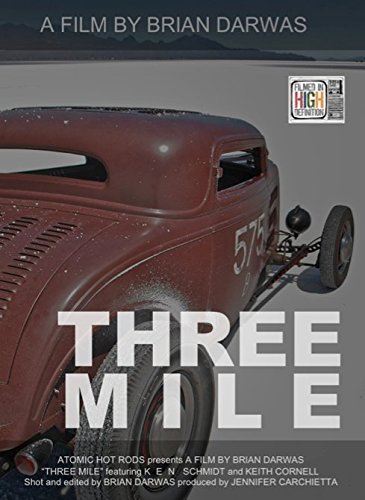
THREE MILE
Join Brian Darwas and the Rolling Bones Hot Rod Shop on a cross country trip full of roadside breakdowns, shop tours, parking lot parties and plenty of racing at what most people consider the birthplace of hot rodding, the legendary Bonneville Salt Flats.
All thirteen hot rods embark on a life time adventure from New York to Utah, where Keith Cornell breaks the world record for the fastest Ford Y-block. With enough salt pit rebuilds, tech inspections, and race runs to keep even the most jaded gearhead one the edge of their seat.
Be there to experience the sun on your face and salt in the air when it all comes down to that THREE MILE pass.
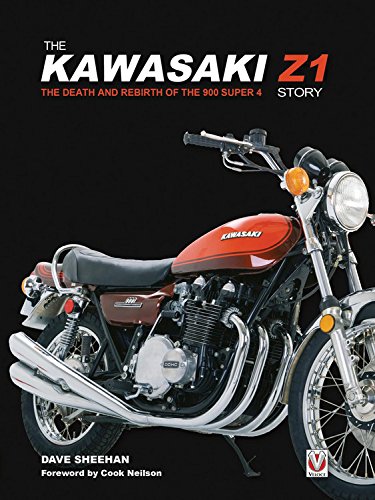
SOLD OUT AWAITING PUBLISHER RE-PRINT
Just as Kawasaki was about to green-light the world’s first mass-produced across-the-frame four-cylinder motorcycle, Honda pulled the rug out from under them, unveiling the CB750-4 at the Tokyo Show in 1968. It lit the fuse for what was to become motorcycling’s most explosive decade. In never before published interviews, with the men responsible for the bike code-named ‘New York Steak,’ Dave Sheehan relates the story behind the Z1’s development; the secret US testing programme in which a team including Imola-race winner Paul Smart rode pre-production bikes disguised as Hondas coast-to-coast across America. The Kawasaki Z1 Story examines the myth, truth and legend surrounding the Z1’s first race win – of which even Kawasaki knew nothing. Here, too, is the full story of the epic three days at Florida’s legendary Daytona Speedway when a trio of Z1s broke more than 50 speed endurance records.

“Antique Auto Body Wood Work for the Restorer” by C.W. Terry with Arthur Hall. This book is largely drawn from “Motor Body Building,” which was published in London and New York in 1914 – the top text in the field, written by Britain’s best experts. You will find details of the principles of design from that era, rules of thumb for proportions of particular body types, and specifications for the wood & metal typically used on bodies. Learn about principles of putting together bodies in that era, such as the selection of timber, ways of chassis framing, design for weight & accommodation, constructing the framework, kinds of joints used in framing, strength and stiffness of materials, stress & strain, panel work, iron work, mounting (to allow for movement), doors & pillars, mudguards, methods for making corners in wood, and much more. The authors give detailed instructions for creating design drawings from the side elevation, cant board (side seen from top), the chassis line, sweeps, proportion in seating, and what makes a good design. Includes illustrations, diagrams, drawing, design and construction of body types, including: Limousine, Limo with quarter windows, limo with fishtail back, limo with round quarters, Cabriolet, Convertible two-seater, Touring (Torpedo), Landaulet, Landaulet with quarter windows, flush side body, and detachable Tonneau (convertible 2-4). 127 pages, softbound . Own this hard-to-find information on a golden age of automobiles.

New York City has one of the finest and largest transit systems in the country. Beginning with early horse-drawn omnibuses, followed by battery-operated streetcars and electric street railway systems, finally by 1947 most of New York converted to buses. After WWII bus manufacturers including General Motors and Mack developed modern, larger buses to the City of New York’s exclusive specifications. This book portrays each of the eleven bus companies (private and city owned) that provided service to patrons from post-WWII era through the late 1970s. A concise history for each company is provided along with route schematics and large format pictures of buses operating in New York City.
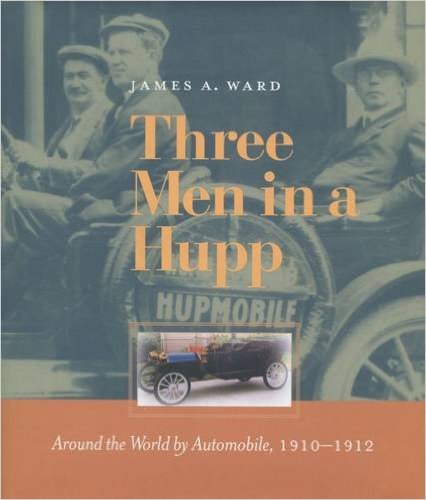
In late 1910, three American adventurers set off on a remarkable around-the-world journey by automobile. Sponsored by the Hupp Motor Car Corporation, the trip was intended to publicize the durability of the Hupmobile and help stimulate export sales.
The car was first driven from Detroit to San Francisco—a very difficult journey in its own right in 1910. From San Francisco, the car and its drivers took a steamship to Hawaii, and from there to Fiji, Australia, New Zealand, and Tasmania, unloading and touring at each port of call. The men and their machine spent the next five weeks attempting to drive through the Philippines, and then pushed on to Japan and China, where they managed to stay one step ahead of the Chinese revolution. They then drove across India, and from there, sailed to Egypt, brining the first automobile ever to be seen in that country. Next, the Hupmobilists sailed to Italy. In Rome, the adventurers met Pope Pius X, and then drove north to Germany and France. They crossed the English Channel to Folkstone, toured England, and then ferried from Liverpool to Ireland. They returned to New York in time for the 1912 auto show.
In the end, the Hupmobile was driven 41,000 miles and transported by steamship another 28,000. A new world was dawning, both for transportation and for American business enterprise.
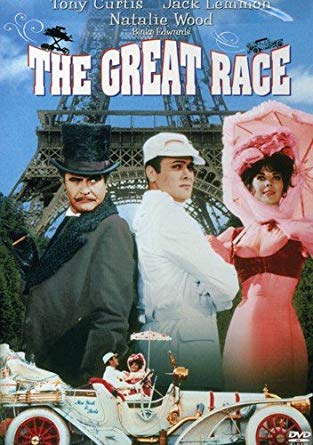
Tony Curtis stars as The Great Leslie, a hero among heroes whose purity of heart is manifested by his spotlessly white wardrobe. Leslie’s great rival, played by Jack Lemmon, is Professor Fate, a scowling, mustachioed, top-hatted, black-garbed villain. Long envious of Leslie’s record-setting accomplishments with airships and sea craft, Professor Fate schemes to win a 22,000-mile auto race from New York City to Paris by whatever insidious means possible. The problem is that Fate is his own worst enemy: each of his plans to remove Leslie from the running (and from the face of the earth) backfires. Leslie’s own cross to bear is suffragette Maggie Dubois (Natalie Wood), who also hopes to win the contest and thus strike a blow for feminism. The race takes all three contestants to the Wild West, the frozen wastes of Alaska, and, in the longest sequence, the mythical European kingdom of Carpania. This last-named country is the setting for a wild Prisoner of Zenda spoof involving Professor Fate and his look-alike, the foppish Carpanian king. When Leslie and Fate approach the finish line at the Eiffel Tower, Leslie deliberately loses to prove his love for Maggie. Professor Fate cannot stand winning under these circumstances, thus he demands that he and Leslie race back to New York.

“””I am no helmeted, begoggled hero of the skies; picture me bookish, bespectacled, unable to hold even a teacup without rattling it. As a pilot, I am merely an amateur, and I know it. . . . I shouldn’t be talking. But I can’t help talking. For you take the air: the thin, substanceless air that can be made to bear a man; you take America; and you take an airplane, which of all the works of man is the nearest to a living being—you take those things and mix them up, and they will act as a drug which will knock all proper reticence right out of you. And so, here I go talking . . .””—from America from the Air In 1927, Charles Lindbergh made his historic solo flight across the Atlantic; Amelia Earhart became the first woman to do so in 1932. And so was born the golden age of flying. Aviators became the era’s new heroes and the airplane its icon. In early 1930s Chicago, a German-born graduate student became fascinated by the airplane and its usefulness as a great geographic and sociological tool. Wolfgang Langewiesche sold his car and used his meager salary to pay for flying lessons at 25 cents a minute. With the same passion America had taken to the road a decade earlier, Langewiesche took to the air. He eagerly inhaled the landscape and breathed observations about the country, writing a series of books that describe the heady excitement and freedom of flight and the stunning views of his adopted country from an entirely new vantage point—the sky. This new edited volume revives the writings from two of his now out-of-print books. America from the Air draws from Langewiesche’s classic account of his early experiences as a pilot, I’ll Take the High Road (first published in 1939 and praised by the New York Times as “”a stirring and revealing story, told with sensitiveness and lucidity and with the warmth of a modest personal charm””), and selections from his 1951 memoir, A Flier’s World, to create a distinctive book that provides a pioneering look at the American landscape as seen from the cockpit of a light plane. Langewiesche’s photographs from his cross-country flights circa 1939 evoke the era. Wolfgang Langewiesche is revered among pilots for his 1944 flying primer, Stick and Rudder, currently in its seventieth printing. Considered the bible of aviation, it tells us the “”how”” of flying; America from the Air tells us the “”why.”” Here his descriptions of the country offer unique perspectives on New England, the Midwest, and the Atlantic Coast from Virginia to Key West, at a time before the country was paved over by multilane expressways, suburban tract housing, and strip malls. His bird’s-eye view of America takes in small farms, deserted seashores, busy railway lines, and cities in which skyscrapers were still engineering marvels. With the keen eye of a surveyor and an uncommon talent for conveying the physical sensation of flying, he describes landscape in all its beauty and detail as it rolls out beneath him, unveiling its mysteries. Langewiesche is revealed here as an infectiously enthusiastic aviator and an unrivaled observer of the American landscape. In a new foreword, Langewiesche’s son, writer William Langewiesche, describes his father’s love of the view from above. Hokanson and Kratz’s introduction and biography update the reader, incorporating stories gleaned from recent interviews with the author.
”

Very few aviation books make the New York Times Best Sellers List. Walter Boyne, former Director of the National Air & Space Museum, is probably the best-selling aviation author today. He and Steven L. Thompson, another noted author, teamed to create this blockbuster novel. This extraordinary work is viewed to be the “book of record” on the opportunities, struggles and achievements available to those who love aviation and combine this love with Air Force careers. It is considered more than a novel. Originally published in 1986 in hardbound and softbound (1987), it promptly sold out, and that was that. Now 13 years later it is available again. Some of the uncompensated praise reviews on the back cover: “impressive,” “a tremendous work,” a “must-read,” and a “wonderfully American story wonderfully told.”
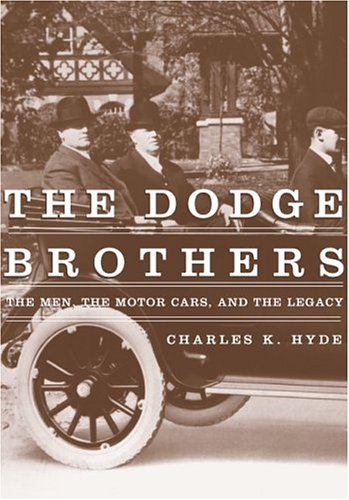
At the start of the Ford Motor Company in 1903, the Dodge Brothers supplied nearly every car part needed by the up-and-coming auto giant. After fifteen years of operating a successful automotive supplier company, much to Ford’s advantage, John and Horace Dodge again changed the face of the automotive market in 1914 by introducing their own car. The Dodge Brothers automobile carried on their names even after their untimely deaths in 1920, with the company then remaining in the hands of their widows until its sale in 1925 to New York bankers and subsequent purchase in 1928 by Walter Chrysler. The Dodge nameplate has endured, but despite their achievements and their critical role in the early success of Henry Ford, John and Horace Dodge are usually overlooked in histories of the early automotive industry.
Charles K. Hyde’s book The Dodge Brothers: The Men, the Motor Cars, and the Legacy is the first scholarly study of the Dodge brothers and their company, chronicling their lives-from their childhood in Niles, Michigan, to their long years of learning the machinist’s trade in Battle Creek, Port Huron, Detroit, and Windsor, Ontario-and examining their influence on automotive manufacturing and marketing trends in the early part of the twentieth century. Hyde details the brothers’ civic contributions to Detroit, their hiring of minorities and women, and their often anonymous charitable contributions to local organizations. Hyde puts the Dodge brothers’ lives and accomplishments in perspective by indicating their long-term influence, which has continued long after their deaths.
The most complete and accurate resource on John and Horace Dodge available, The Dodge Brothers uses sources that have never before been examined. Its scholarly approach and personal tone make this book appealing for automotive historians as well as car enthusiasts and those interested in Detroit’s early development.
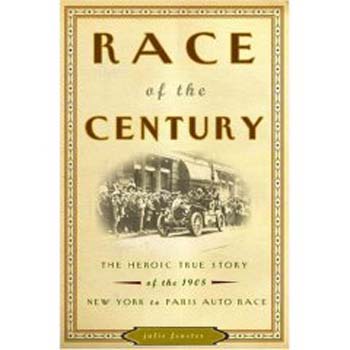
“17 men, 6 cars, and a 21,000-mile race across 3 continents
On the morning of February 12, 1908, six cars from four different countries lined up in Times Square, surrounded by a frenzied crowd. The men who competed in the New York to Paris auto race were an international roster of personalities: a charismatic Norwegian outdoorsman, a witty French nobleman, a pair of Italian sophisticates, an aristocratic German army officer, and a cranky mechanic from Buffalo, New York. At a time when most people had never seen an automobile, these adventurous men set their course over mountain ranges, through Arctic freeze, and desert heat. There were no gas stations, no garages, and no replacement parts in case of emergency.
Two men rose to the top. Ober-lieutenant Hans Koeppen, a rising officer in the Prussian army, led the German team in their canvas-topped 40-horsepower Protos. His amiable personality belied a core of sheer determination, and by the race’s end, he had won the respect of even his toughest critics. His counterpart on the U.S. team was George Schuster, a blue-collar mechanic who led the Americans in their lightweight 60-horsepower Thomas Flyer. A born competitor, Schuster battled Koeppen until the very end. Ultimately the German and the American would be left alone in the race, fighting the elements, exhaustion, and each other until the winning car’s glorious entrance into Paris, on July 30, 1908.”
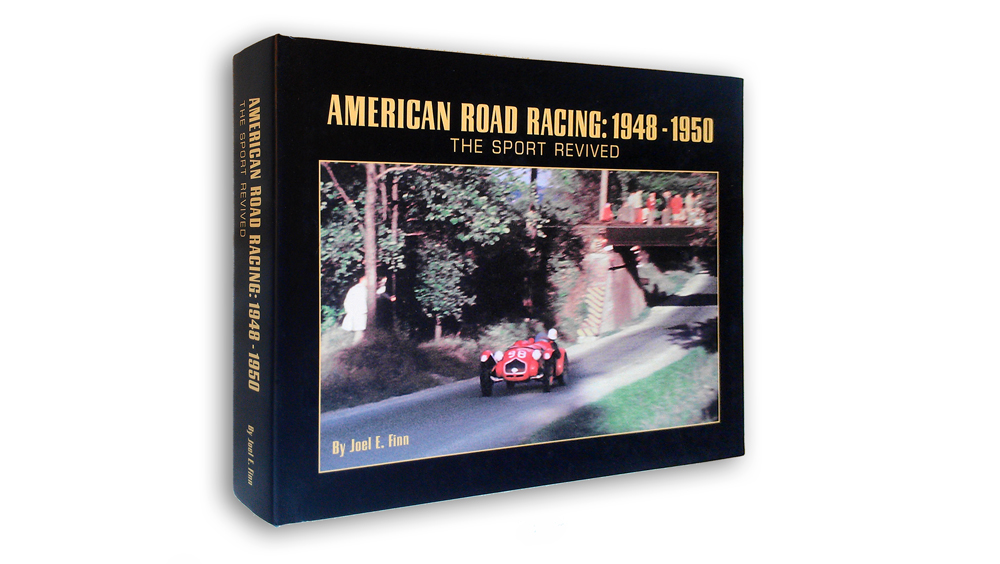
Joel Finn’s latest definitive book features the complete history of how American road racing began anew after World War II and grew into a major sport in the United States. Following the formation of the Sports Car Club of America, the reintroduction of road racing began at Watkins Glen, New York on October 2, 1948.
The popularity of the sport exploded over the next few years, as racers and organizers struggled to keep up with inevitable changes. The challenges of initiating, staging, organizing and managing these events, many on held on public roads, posed many problems and created a good deal of dissension amongst competing groups and powerful individuals. Author Finn lays out the dramatic story of these crucial early years of American road racing with superb accuracy and the immediacy of first hand experience.
Includes more than 600 photos, illustrations and race charts. 435pp. large format, hard-bound.

It started as a daydream. Poring over a map of the world at home one quiet Saturday afternoon, Ewan McGregor — acclaimed actor and self-confessed bike nut — noticed that it was possible to ride all the way round the imageworld, with just one short hop across the Bering Strait from Russia to Alaska. It was a revelation he couldn’t get out of his head. So he picked up the phone and called his fellow actor-slash-biker friend Charley Boorman and told him it was time to hit the road….
Beginning in London, Ewan and Charley chased their shadows through Europe, the Ukraine, Kazakhstan, Mongolia, and Russia; across the Pacific to Alaska; then down through Canada all the way to New York. Long Way Round is the result of their four-month, 20,000-mile joyride. Featuring original diary entries, travel maps, mileage charts, and dozens of photographs, this is a freewheeling, fully charged, and uproariously entertaining book about two world-famous individuals who chose the road not taken…and made the journey worthwhile.

On June 19, 1953, Harry Truman got up early, packed the trunk of his Chrysler New Yorker, and did something no other former president has done before or since: he hit the road. No Secret Service protection. No traveling press. Just Harry and his childhood sweetheart Bess, off to visit old friends, take in a Broadway play, celebrate their wedding anniversary in the Big Apple, and blow a bit of the money he’d just received to write his memoirs. Hopefully incognito.
In this lively history, author Matthew Algeo meticulously details how Truman’s plan to blend in went wonderfully awry. Fellow diners, bellhops, cabbies, squealing teenagers at a Future Homemakers of America convention, and one very by-the-book Pennsylvania state trooper all unknowingly conspired to blow his cover. Algeo revisits the Trumans’ route, staying at the same hotels and eating at the same diners, and takes readers on brief detours into topics such as the postwar American auto industry, McCarthyism, the nation’s highway system, and the decline of Main Street America. By the end of the 2,500-mile journey, you will have a new and heartfelt appreciation for America’s last citizen-president.
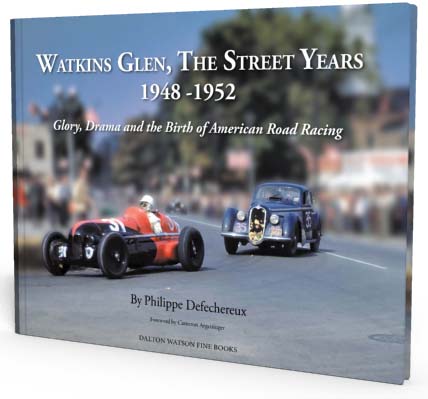
In 1948 Watkins Glen staged the first official American race for sports cars since the Vanderbilt Cup races of the early years of the century. This book is about the transformation of post-World War II racing in America and how road racing became a leading sport in the US, beginning at Watkins Glen and followed by Sebring, Daytona, Laguna Seca and other circuits.
These historic first five years are fundamental to road racing in America when the race was staged through the village streets and neighboring countryside until a permanent track was built in 1953. The races introduced famous international marques such as Ferrari, Jaguar, Porsche, Allard, Healey and Cunningham and encouraged a pantheon of great drivers to develop, among them, Briggs Cunningham, John Fitch, Phil Walters, Phil Hill, Jim Kimberly and Walt Hansgen. Later, from 1961 to 1980, Watkins Glen was the site of the Formula 1 United States Grand Prix.
Cameron Argetsinger, a lawyer and leader in upstate New York, was the man with the dream and the story of how he made it all happen against enormous odds is told in detail. It includes anecdotes and interviews contributed by many of the early participants, and has exclusive color photographs taken during years when color photography was practically unknown.
In 2011, Watkins Glen celebrates the 50th anniversary of its first Formula 1 Grand Prix. Had the early Sports Car Grand Prix of 1948-52 not taken place and quickly become a huge popular success, Watkins Glen would long ago have disappeared in the annals of history. Instead, it remains to this day a challenging race track, with two nationally televised events each year, and it is the home of the world’s first Motor Racing Research Library.
Over 300 photographs provide vivid and fascinating illustrations of the men and machines who threaded together every part of this extraordinary story. Full race results and statistics for all entrants in the 13 races run between 1948 and 1952 are also provided in detail. A final chapter shows how many of the race cars from the early years are now highly valued and are prize-winners at concours events.
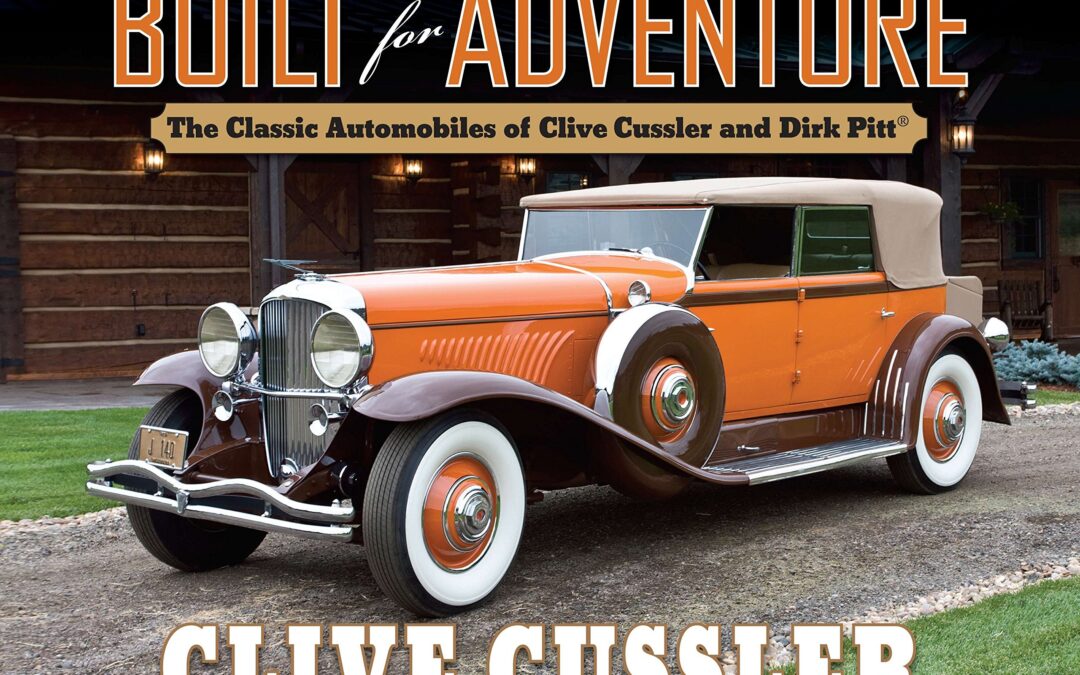
A photographic tour through Clive Cussler’s outstanding collection of antique automobiles, including those featured in his #1 New York Times bestselling Dirk Pitt series.
Fans of Clive Cussler’s bestselling Dirk Pitt series know that his hero has a soft spot for rare and classic automobiles…and that the vehicles that appear in the novels are actually part of Cussler’s own vast collection. Through stunning color photographs and warm, informative commentary, fans of Cussler and Pitt can see fifty-six of these automobiles in all their glory, and learn about the history and acquisition of each classic car. Rolls-Royce Silver Ghost Touring . . . Mercedes-Benz 630K . . . Duesenberg J-140 . . . Cadillac V-16 Roadster . . . Ford Cabriolet Hot Rod . . . Packard V-12 . . . it’s a car lover’s paradise!
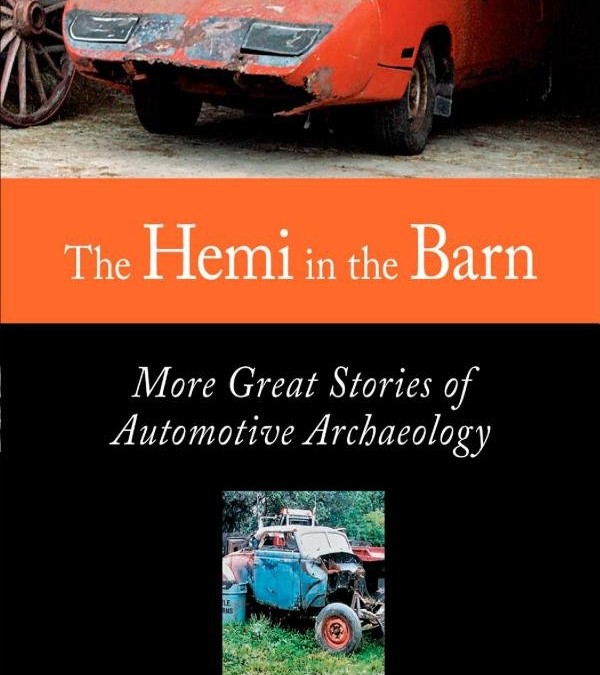
It’s every car lover’s fantasy: the perfectly preserved classic automobile discovered under a blanket in some great-granny’s garage. And as author Tom Cotter has discovered time and again, it’s a fantasy that can come true. The Hemi in the Barn offers more than forty stories of amazing finds and automotive resurrections. Avid collectors big and small recall the thrills of the hunt, the tips and hunches followed, clues pursued, the heart-stopping payoff. There’s the forgotten Duesenberg—probably one of the last unrestored ones around—that Jay Leno found in a Burbank garage. Unbelievably, Leno found another Duesenberg in a parking garage in New York City—a car that was parked in 1933 and never moved. There’s a Plymouth Superbird found buried in a hedge in Alabama. There’s the rescue of the first 1955 Corvette ever built. As entertaining as these tales are, they’re also full of tantalizing hints and suggestions for readers setting off on their own adventures in automotive archaeology.
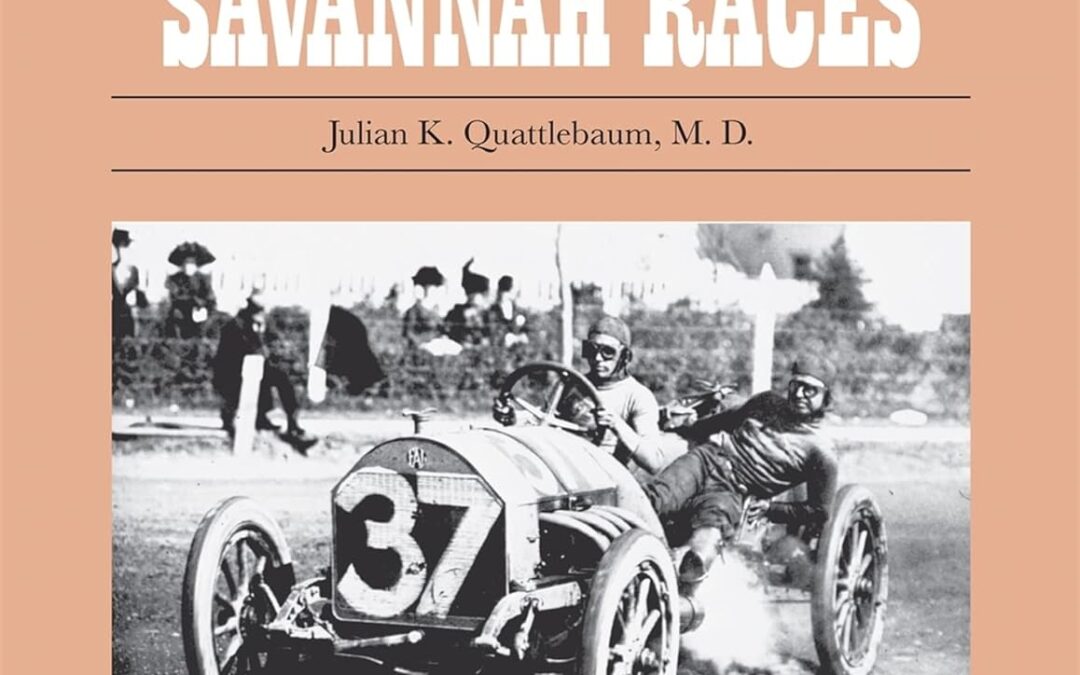
While automobile races had been held in Europe earlier, it was not until after 1900 that organized races were held in the United States. These contests took the form of road races―usually over a series of connected links of the best roads available. The most important of the early races were held on Long Island, New York.
As a result of the efforts of the Savannah Automobile Club, the International Grand Prize Race of the Automobile Club of America was held in Savannah, Georgia, for the first time in November of 1908 and was enormously successful. In 1910 and again in 1911 the most famous drivers and the finest racing cars from all over the world returned to the city for the Grand Prize Race. The 1911 event attracted thousands more who came to witness the famous Vanderbilt Cup Race, the fastest race of this length up to that time (291 miles in 3 hours and 56 minutes).
Julian K. Quattlebaum was among those who lined the Savannah race course for a glimpse of the big Fiats, Loziers, and Mercedes that roared around the turns, across the finish line, and into auto racing history. He has written a new introduction to this edition and has gone through his collection of early photographs of the cars, the drivers, and the races to add to the generous selection of illustrations in the original edition.
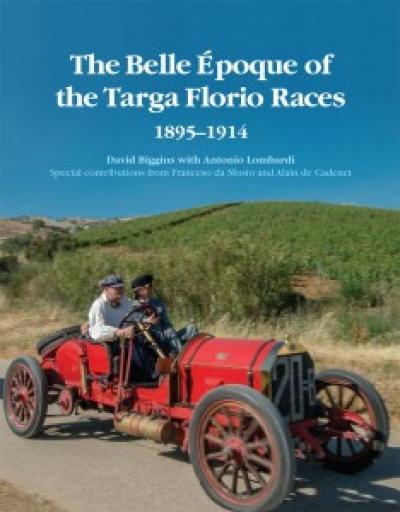
“The Belle Epoque (The Beautiful Age) coincides with the period of Edwardian extravagance so well depicted in the now famous TV series “Downton Abbey”. During this era, at the turn of the 20th century, Paris was the epicentre of fashion and art , London of society and class, Vienna of intellectual activity. New York’s own golden age was based on money, that classic American value!
There was an ebullient atmosphere everywhere , decadent and magnificent at the same time, coinciding with the momentous changes brought by modern inventions including wireless communication, the automobile, and the airplane. The privileged and moneyed classes enjoyed lives of extravagant luxury in sharp contrast to the desperate lives of the under classes, urban and rural. This contrast was even more evident in Sicily, where so many still endured medieval conditions. Palermo was one of Europe’s capitals of the period, visited regularly by royalty including the Czar of Russia and Germany’s Kaiser.
During those same years Vincenzo Florio, scion of Sicily’s leading family, created his eponymous race, the Targa Florio. He was only 23 when its first edition took place in 1906, but the honor committee included the presidents of the Automobile Clubs of the United Kingdom, France and Germany. Florio intended Sicily to be at the center of the blossoming new world of auto racing . He succeeded beyond his wildest dreams, and his story is being made into a movie titled ” Pistons, Passions & Sicilian Pleasures”. It will recount the early life of Vincenzo Florio and his friend and protege Felice Nazzaro, destined to become one of the greatest drivers of all time.
As a prelude to the release of the film, Upfolds Publishing announces the publication of the companion book..
The book narrates the experience of making this film. It is rich in illustration both historical and modern. The photographic artist Becca Parker captures both the beautiful landscapes of Sicily and the excitement of one hundred year old racing cars, reliving the passions of the Targa Florio, the oldest race in the world.
The book is a hard covered coffee table style in high definition.
“






















